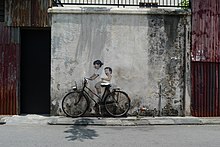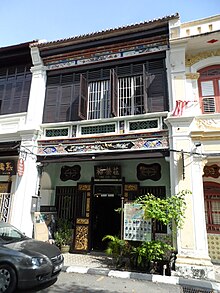
Penang is a Malaysian state located on the northwest coast of Peninsular Malaysia along the Strait of Malacca. It has two parts: Penang Island, where the capital city, George Town, is located, and Seberang Perai on the Malay Peninsula. These two halves are physically connected by the Penang Bridge and the Second Penang Bridge. The state shares borders with Kedah to the north and east, and Perak to the south.

Sun Yat-sen was a Chinese revolutionary, statesman, and political philosopher who served as the provisional first president of the Republic of China and the first leader of the Kuomintang (KMT). Uniquely among 20th-century Chinese leaders, Sun is revered by both the Republic of China on Taiwan and by the People's Republic of China for his instrumental role in the 1911 Revolution that successfully overthrew the Qing dynasty.

George Town is the capital of the Malaysian state of Penang. It is the core city of the George Town Conurbation, Malaysia's second largest metropolitan area with a population of 2.84 million and the second highest contributor to the country's GDP. The city proper spans an area of 306 km2 (118 sq mi) encompassing Penang Island and surrounding islets, and had a population of 794,313 as of 2020.

The Tongmenghui of China was a secret society and underground resistance movement founded by Sun Yat-sen, Song Jiaoren, and others in Tokyo, Empire of Japan, on 20 August 1905, with the goal of overthrowing China's Qing dynasty. It was formed from the merger of multiple late-Qing dynasty Chinese revolutionary groups.
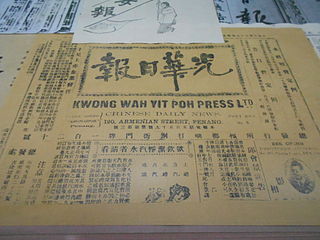
Kwong Wah Yit Poh or Kwong Wah Daily is a Malaysian Chinese daily that was founded in 1910 by Chinese revolutionary Sun Yat-sen. It is the oldest surviving Chinese-language newspaper in Southeast Asia.

The State of Penang, one of the most developed and urbanised Malaysian states, is located at the nation's northwest coast along the Malacca Strait. Unlike most Malaysian states, the history of modern Penang was shaped by British colonialism, beginning with the acquisition of Penang Island from the Sultanate of Kedah by the British East India Company in 1786. Developed into a free port, the city state was subsequently governed as part of the Straits Settlements, together with Singapore and Malacca; the state capital, George Town, briefly became the capital of this political entity between 1826 and 1832. By the end of the 19th century, George Town prospered and became one of the major entrepôts in Southeast Asia.
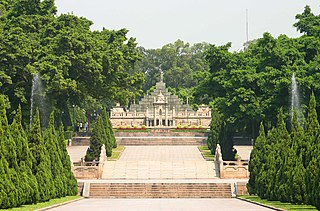
The Second Guangzhou (Canton) Uprising, known in Chinese as the Yellow Flower Mound Uprising or the Guangzhou Xinhai Uprising, was a failed uprising took place in China led by Huang Xing and his fellow revolutionaries against the Qing dynasty in Canton (Guangzhou). It is honored in Guangzhou's Yellow Flower Mound or Huanghuagang Park.

Farlim, officially Bandar Baru Ayer Itam, is a residential neighbourhood within the city of George Town in the Malaysian state of Penang. Located 6 km (3.7 mi) southwest of the city centre, the township was created in the 1980s. Over the recent decades, Farlim has witnessed rapid development with several residential and commercial developments within the area.
Road to Dawn is a 2007 Chinese historical film directed by Hong Kong filmmaker Derek Chiu. The film depicts an obscure episode in Sun Yat-sen's revolutionary life, when he sought refuge in Penang from July to December 1910. He relocated the Southeast Asian headquarters of his political party, the Tongmenghui, to Penang and convened the Penang Conference to stage the Second Guangzhou Uprising.

Tye Kee Yoon was a Vice Consul of Qing dynasty China in Penang, one of the founders and 'Five Great Sponsors,' of the Kek Lok Si owned property in Perak, and was proprietor of a business named Chop Hen Choong Toong. He arrived at Penang, a penniless coolie from China, in 1873, but by December 1907, had risen to the prominent position of diplomat. Success and recognition followed that appointment. He became a Revenue Farmer, and succeeded in obtaining the Gambling Farm for Taiping (Perak), the following year. In 1910 he was appointed to the Committee of the District Hospital, Penang. Disaster soon followed success beginning with the death of his wife, Khoo Lye Neoh on Sunday 6 April 1913 and later that year, on Friday 14 November, of his daughter, the wife of Khoo Chye Hean.
The 1910 Penang conference was a meeting held at 404 Dato' Kramat Road in Penang on 13 November 1910, by Sun Yat-sen to stage a major revolt. The following day, on 14 November 1910, Sun Yat-sen chaired an Emergency Meeting of the Tongmenghui at 120 Armenian Street, now the Sun Yat-sen Museum Penang, and raised Straits Dollars $8,000 on the spot. The meeting focused on fund raising and the planning of a final revolution to overthrow the Qing dynasty that would make or break the Tongmenghui.

The Sun Yat-sen Museum Penang formerly called the Sun Yat-sen Penang Base, is a museum in George Town, Penang, Malaysia. The museum is dedicated to Sun Yat-sen, a Chinese nationalist who established the Republic of China after his efforts in the Xinhai Revolution.
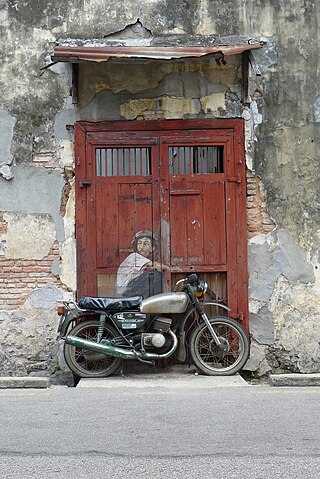
Ernest Zacharevic is a multidiscipline contemporary and public artist based in Penang, Malaysia.
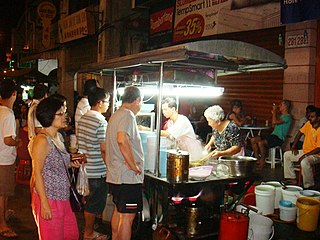
Penangite Chinese are ethnic Chinese Malaysians of full or partial Chinese ancestry who either hail from or live within the State of Penang. As of 2020, 45% of Penang's population belonged to the Chinese ethnic group, making ethnic Chinese the largest ethnic community within the state.

Weld Quay is a coastal road in the city of George Town within the Malaysian state of Penang. One of a handful of places worldwide that was named after a Prime Minister of New Zealand, the road runs along the city's eastern shoreline, connecting the Tun Dr. Lim Chong Eu Expressway with Light Street and Beach Street.

Leith Street is a narrow road within the UNESCO World Heritage Site of the city of George Town within the Malaysian state of Penang. Once known as an enclave for rich Hakka tycoons, it is home to the famous Cheong Fatt Tze Mansion.

Dato Keramat Road is a major thoroughfare in the city of George Town within the Malaysian state of Penang. It is one of the main roads leading out of the city centre towards the suburb of Ayer Itam.

Macalister Road is a major thoroughfare in the city of George Town within the Malaysian state of Penang. The road stretches out of Magazine Circus next to Komtar towards Western Road, a leafier enclave within the city centre.

George Town, the capital city of the state of Penang, is the second largest city in Malaysia and the economic centre of the country's northern region. The history of George Town began with its establishment by Captain Francis Light of the British East India Company in 1786. Founded as a free port, George Town became the first British settlement in Southeast Asia and prospered in the 19th century as one of the vital British entrepôts within the region. It briefly became the capital of the Straits Settlements, a British crown colony which also consisted of Singapore and Malacca.
Penang is a diverse multiethnic and multicultural society. Residents of the state are colloquially known as Penangites or "Penang-lang". Traditionally regarded as a Chinese-majority state, the Bumiputera population, which includes ethnic Malays, has reached parity with that of the Chinese in recent years.

